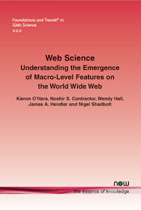Web Science: Understanding the Emergence of Macro-Level Features on the World Wide Web
By Kieron O'Hara, University of Southampton, UK, kmo@ecs.soton.ac.uk | Noshir S. Contractor, Northwestern University, USA, nosh@northwestern.edu | Wendy Hall, University of Southampton, UK, wh@ecs.soton.ac.uk | James A. Hendler, Rensselaer Polytechnic Institute, USA, hendler@cs.rpi.edu | Nigel Shadbolt, University of Southampton, UK, nrs@ecs.soton.ac.uk
Abstract
In this monograph we consider the development of Web Science since the launch of this journal and its inaugural publication 'A Framework for Web Science' [44]. The theme of emergence is discussed as the characteristic phenomenon of Web-scale applications, where many unrelated micro-level actions and decisions, uninformed by knowledge about the macro-level, still produce noticeable and coherent effects at the scale of the Web. A model of emergence is mapped onto the multitheoretical multilevel (MTML) model of communication networks explained in [252]. Four specific types of theoretical problem are outlined. First, there is the need to explain local action. Second, the global patterns that form when local actions are repeated at scale have to be detected and understood. Third, those patterns feed back into the local, with intricate and often fleeting causal connections to be traced. Finally, as Web Science is an engineering discipline, issues of control of this feedback must be addressed. The idea of a social machine is introduced, where networked interactions at scale can help to achieve goals for people and social groups in civic society; an important aim of Web Science is to understand how such networks can operate, and how they can control the effects they produce on their own environment.
Web Science
Understanding the Web is a problem on a par with other complex scientific challenges such as climate change or the human genome. The requirement for understanding should ideally be accompanied by some measure of control, which makes Web Science crucial in the future provision of tools for managing our interactions, our politics, our economics, our entertainment, and — not least — our knowledge and data sharing. The Web is a critical infrastructure that underpins increasingly many of our transactions, and yet is barely understood by policymakers.
This monograph considers the development of Web Science since the publication 'A Framework for Web Science' (Berners-Lee et al., 2006). The theme of emergence is discussed as the characteristic phenomenon of Web-scale applications, where many unrelated micro-level actions and decisions, uninformed by knowledge about the macro-level, still produce noticeable and coherent effects at the scale of the Web. A model of emergence is mapped onto the multitheoretical multilevel (MTML) model of communication networks explained by Monge and Contractor (2003). Four specific types of theoretical problem are outlined. First, there is the need to explain local action. Second, the global patterns that form when local actions are repeated at scale have to be detected and understood. Third, those patterns feed back into the local, with intricate and often fleeting causal connections to be traced. Finally, as Web Science is an engineering discipline, issues of control of this feedback must be addressed. The idea of a social machine is introduced, where networked interactions at scale can help to achieve goals for people and social groups in civic society; an important aim of Web Science is to understand how such networks can operate, and how they can control the effects they produce on their own environment.
Web Science explains the motivating issues for Web Science. It shows not only how research has addressed the gap between the micro-level processes and the macro-level Web-scale phenomena to which they give rise but also why research is still needed to do that.
